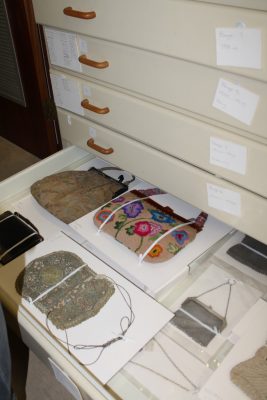For 15 years, Neil Stuart-Harris has presided over a remarkable collection of clothes and costumes from Durban’s past. He is the textile conservator at the Local History Museum’s Conservation Centre and he allowed us to stepped into this delicate, intricate world, where very few have been.
“Each item of clothing or accessory is already a piece of history. The idea behind what I do is to preserve it well enough to make it last another 100 years.”
In charge of a collection of clothing and accessories dating back to 1662, Neil’s role as a preventative conservator is to try and prevent any further deterioration of the items in his care. He does so through gentle vacuuming, washing and whatever physical intervention he may deem fit.

It is clear that Neil is passionate about his job. “I love what I do. It is hellishly self-indulgent, but it’s what makes me tick! There are challenges, of course. My work involves making technical examinations, documenting conditions, performing conservation treatment, installing textiles for exhibitions and, after an exhibition, preparing textiles for storage. What most don’t realise is that once you start working on something like this, there is no going back. There is a fine line between preserving something and destroying it.”
According to Neil, all materials respond to their immediate environment. High relative humidity is conducive to mould growth and fluctuating relative humidity causes organic materials like wood, ivory, and paper to expand and contract, leading to cracks, broken paint, and warping. Things like dust, sand grains and soot are carried into the conservation centre from urban and agricultural environments and sharp grains like sand lead to abrasion of object surfaces. Soot is grimy and acidic leading to discolouration, embrittlement of organic materials and corrosion of metals.
“Nothing is indestructible. Items that were once strong and wearable have become fragile over time and can be destroyed upon the slightest touch. We live in a world where we consume and then we pass on or discard when we’ve outgrown or out loved. Since the museum was established in the 1950s, items of clothing have been donated with the purpose of being preserved and treasured. It is my job to make sure this is achieved in the most effective way.”
Meticulous and dedicated, Neil says it took him an entire year to work through everything in the collection when he first started working at the Conservation Centre. He had to learn to make sense of it all with little information, no photos or proper descriptions.

FROM THE STAGE TO THE MUSEUM
“I’ve always had an interest in clothing and textiles. I’m a period costume cutter by trade and from 1984 the Playhouse was my playground as I worked my way up to head wardrobe and costume designer.”
”Neil actually performed in the theatre when he was much younger, but soon realised his passion lay in the technical side. For many years, Neil was responsible for the dazzling and sophisticated costume creations for a wide variety of South African theatre productions including My Fair Lady, The Sound of Music, Chicago, Cabaret, Into the Woods, Oliver, Oklahoma and many others. It was a demanding and deadline-driven line of work, but he thrived in it.
“Some of these productions required completing up to 200-plus garments leading up to dress rehearsals. Not all were started from scratch, but it was intense for what was required in a fairly short space of time. I was really passionate about what I did.
After I was retrenched in 1998 I continued dressmaking in the wedding industry and for matric dances, and doing the occasional theatre work.”
Neil took up his position at the Conservation Centre in 2005.
“Being involved in a conservation treatment of any kind of accessory, tapestry or textile fragment is as thrilling as it is dreaded at times.
“While it can be touch-and-go making the choice to wash, vacuum or intervene, I am always captivated by the transformation a piece has undergone during conservation. It could be an item of clothing dating back to 1770 or a piece of embroidery dating back to 1662. It’s not as simple as throwing it in a washing machine. There are special methods to vacuuming and washing, and it can take hours to do one piece.”
Although treatment of an object may sometimes be necessary, Neil says treatment alone is not sufficient to preserve collections for future. “Objects inevitably deteriorate, but my goal as a preserver of material culture is to slow the rate of deterioration as far as possible. Preventive conservation efforts aim to reduce damage and deterioration to collections by improving their environment.”

How Neil handles (with gloves and care), how he stores (in imported boxes and using material that doesn’t contribute to the degradation of the piece such as acid-free material, pure cotton or melinex that does not give off gas or chemicals that can further harm the already delicate textiles) all matter to his day-to-day tasks and when it comes to how well something will be preserved.
From frocks, collars and neck ties to army uniforms, purses and calling card pouches, everything is researched, preserved, tagged and stored with ease of reference so that they can be easily accessed.

“The most exciting piece I ever worked on was a rickshaw puller’s headdress in 2007. Apart from the massive task involved in cleaning it, just seeing the layers of history passed down from father to son, each having added their own embellishments, was incredibly exciting.
Although Neil is retiring soon, he will be continuing his work in a private capacity.
“There is so much more to learn from what I do, which makes working on these textiles so inspiring. I wake up knowing that I am responsible for preserving a piece of Durban’s history and feel privileged for having had the experience.”






